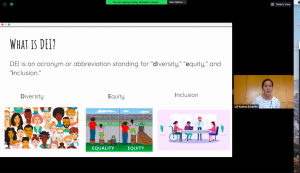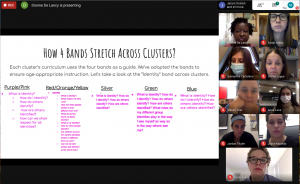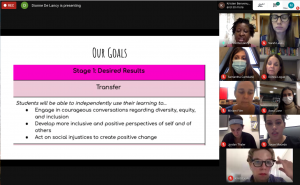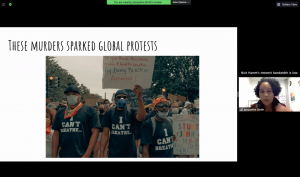
Head Teacher Audrey Schaefer gives a presentation to Green and Silver Cluster classes on the DEI curriculum.
As the new school year begins, our community continues to reflect on the impact of the racial and social injustices that remain at the forefront of our nation, and to brainstorm ways to incorporate teachings on these issues into the classroom.
Over the summer, a team of educators worked to create a Diversity, Equity, and Inclusion curriculum that would be incorporated at Gaynor beginning this fall.
The team included Librarian Dionne De Lancy, Assistant Teacher Jenine Gaynor, Head Teacher Audrey Schaefer, and Science Specialist Jacqueline Smith.
“We were tasked with Gaynorizing a racial literacy curriculum for our students,” Ms. De Lancy said. “Because these social issues are so huge, we decided we want to focus solely on racial literacy for this school year.”
The curriculum was divided into four different categories, also known as bands, for classes to work on throughout the year. The bands are: identity, respect, social justice, and combating inequality.

Librarian Dionne De Lancy gives a presentation to Red, Orange, and Yellow Cluster teachers on the DEI curriculum.
The team used resources from Pollyanna and Teaching Tolerance, as well as their own knowledge and research on the topics. They then blended all of these together to create curriculum maps and units for each topic, differentiated by cluster. These units include goals, essential questions, activities, and more.
The pre-made lessons were then shared with every teacher so they could incorporate them into their classrooms. There are 10 lessons, and teachers will teach one a month for the entire school year.
While the lessons are complete with instructions and resources, each one has the flexibility for teachers to modify it and make it their own in order to best fit their needs, as each class at Gaynor is different.
Ms. De Lancy said, “I think in a way it’s giving our teachers confidence to do the work. Sometimes people are unsure about what to say or what to do. Everyone wants to do the right thing, so I think this gives teachers the confidence to do it and to know that we are a resource for them to reach out to if they have questions.”
Ms. Gaynor said the curriculum helps provide the right resources to faculty in order to help them be the allies they want to be and support Gaynor’s students and staff of color.

Librarian Dionne De Lancy gives a presentation to Red, Orange, and Yellow Cluster teachers on the DEI curriculum.
“I think the resources that we put together are what they’ve been wanting for a long time, and we kind of quenched their thirst,” she said. “We also created this curriculum in the sense that wherever we are, we can still move with this curriculum. If we ever had to pivot to distance learning again, our curriculum fits that space as well, and whatever space we’re in, the curriculum will move along just the same at Gaynor.”
An example of this flexibility can be seen in the Instructional Library, created by Ms. Gaynor, that will have appropriate books for each cluster. This digital resource showcases different books that can be used in the lessons, with each cover having a link to a read aloud of that book.
While the curriculum is new to Gaynor, the idea behind it and the desire to teach students to be change makers has been around for a while.
Ms. Schaefer said that Gaynor faculty and staff had been calling for resources, and this spring the fire was sparked under them to create the curriculum over the summer.
The curriculum also helps to model real life by showing that learning and growing is not a one-time process, but something that happens over the course of a lifetime.
Ms. Schaefer said, “It’s exciting that this is happening all the way from kindergarten through eighth grade, and it’s happening year after year after year and just building upon itself. It makes the students observant and ready to engage in those conversations that need to be had, but it also showcases that this is a lifelong process, and no one has one lesson and all of a sudden they understand everything about racial and social justice issues”

Science Specialist Jacqueline Smith gives a presentation to Green and Silver Cluster classes on the DEI curriculum.
Ms. Smith said having both teachers and students engaging in a curriculum like this helps everyone to be more empathetic and understanding when they go out into the community, and helps minimize the amount of microaggressions and racial injustices.
“For me, the whole point of this is for our school, our community, to be proactive and not reactive,” she said. “At the end of the year when George Floyd was murdered, we really felt the need to come together as a community, but I don’t know if we had the tools to know how exactly, and I don’t know if we had the language to have those conversations both with each other and with our kids. So our goal with this curriculum is to have it embedded into our community, have these conversations in explicit ways, so that we’re pushing each other and our children to talk about this. Then, when an instance of racial injustice comes up, it’s not, ‘Oh my goodness, what do we do?’ It’s, ‘OK, we know where this is coming from, let’s talk about it, and how do we act accordingly?’”
Each cluster will participate in a virtual assembly where the curriculum will be introduced and explained. Deeper discussions will then continue in each pod.
While the curriculum has been created and presented, the team is determined to consistently work on it to expand and improve the curriculum every year.
In the words of Ms. Smith, “We still have work to do!”
